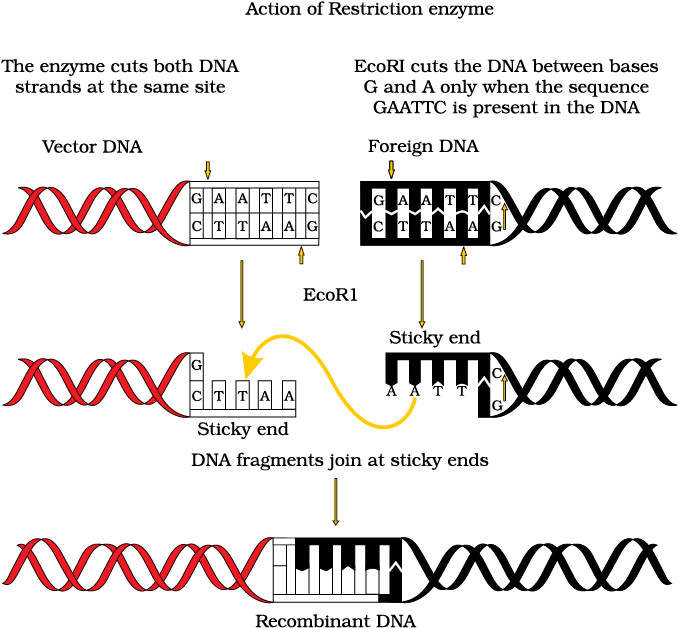Tools of Recombinant DNA Technology
- Restriction enzymes
- Polymerase enzymes
- Ligases
- Vectors
- Host organism
Restriction Endonuclease
- Restriction enzymes belong to a larger class of enzymes called nucleases. Nuclease enzymes cut the DNA at specific positions.
- Nucleases are of two kinds – exonucleases and endonucleases.
- Exonucleases remove nucleotides from the ends of the DNA whereas, endonucleases make cuts at specific positions within the DNA.
- Restriction endonuclease is a nuclease enzyme that cut DNA into fragments at specific recognition sites or restriction sites within DNA molecule.
- The first restriction endonuclease – Hind II.
- In the year 1963, the two enzymes responsible for restricting the growth of bacteriophage in Escherichia coli were isolated.
- Methylase: Methylase adds methyl group to DNA, which prevent the action of restriction enzyme.
- Restriction Enzyme: It cut bacteriophage DNA.
Nomenclature of Restriction Endonuclease
- First letter – From Genus of bacteria (in capital)
- Next two letter – From species (in small)
- Next letter – Strain of bacteria
- Last Roman Number – Order in which enzymes were isolated.
- Example: EcoRI – E = Escherichia
- co = coli
- R = RY strain
- I = First enzyme to be isolated from Escherichia coil.
Recognition Sequence
Each restriction endonuclease cut DNA molecules at a particular point by recognizing a specific palindromic sequence (6 bps), this specific base sequence is known as recognition sequence.
Palindromic Sequence
The palindrome in DNA is a sequence of base pairs that reads same on the two strands when orientation of reading is kept the same. Example:
5’——GAATTC——3’
3’——CTTAAG——5’
Sticky Ends
When we cut a DNA with restriction endonuclease enzyme, it cut the strand a little away from the center of the palindrome sites, but between the same two bases on the opposite strands. This leaves single stranded overhanging stretches, called sticky ends. They are named so because of tendency to form hydrogen bonds with their complementary cut counterparts. This stickiness of the ends facilitates the action of the enzyme DNA ligase.
Action of Restriction Endonuclease
- When cut by the same restriction enzyme, the resultant DNA fragments have the same kind of ‘sticky-ends’.
- These sticky ends tend to form hydrogen bonds with their complementary cut counterparts.
- This stickiness of the ends facilitates the action of the enzyme DNA ligase.
- Now they can be easily combined to form rDNA.

Leave a Reply